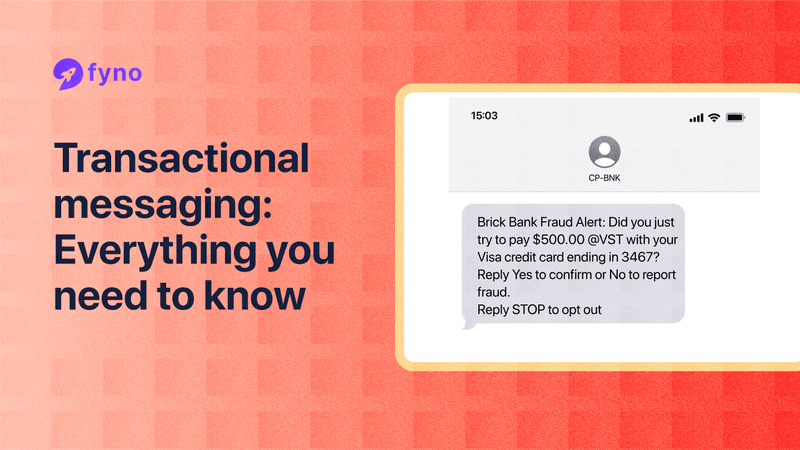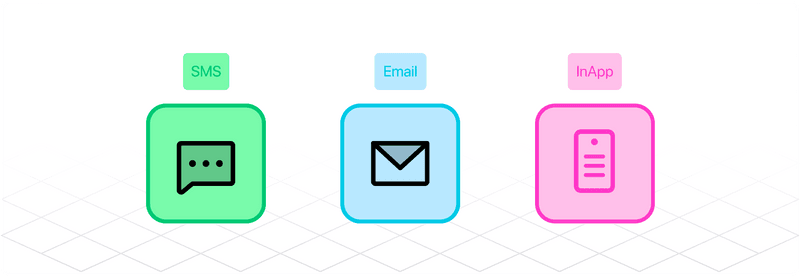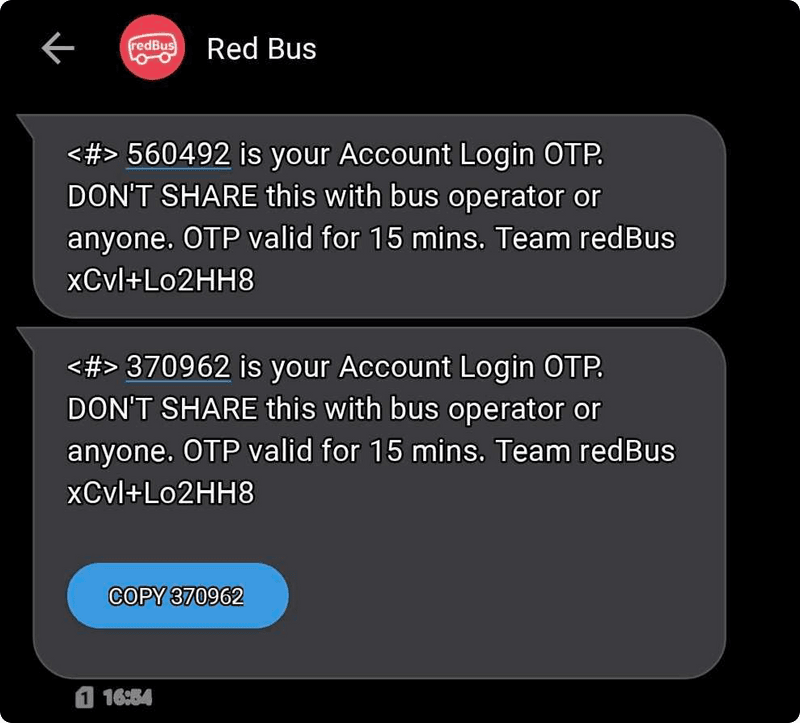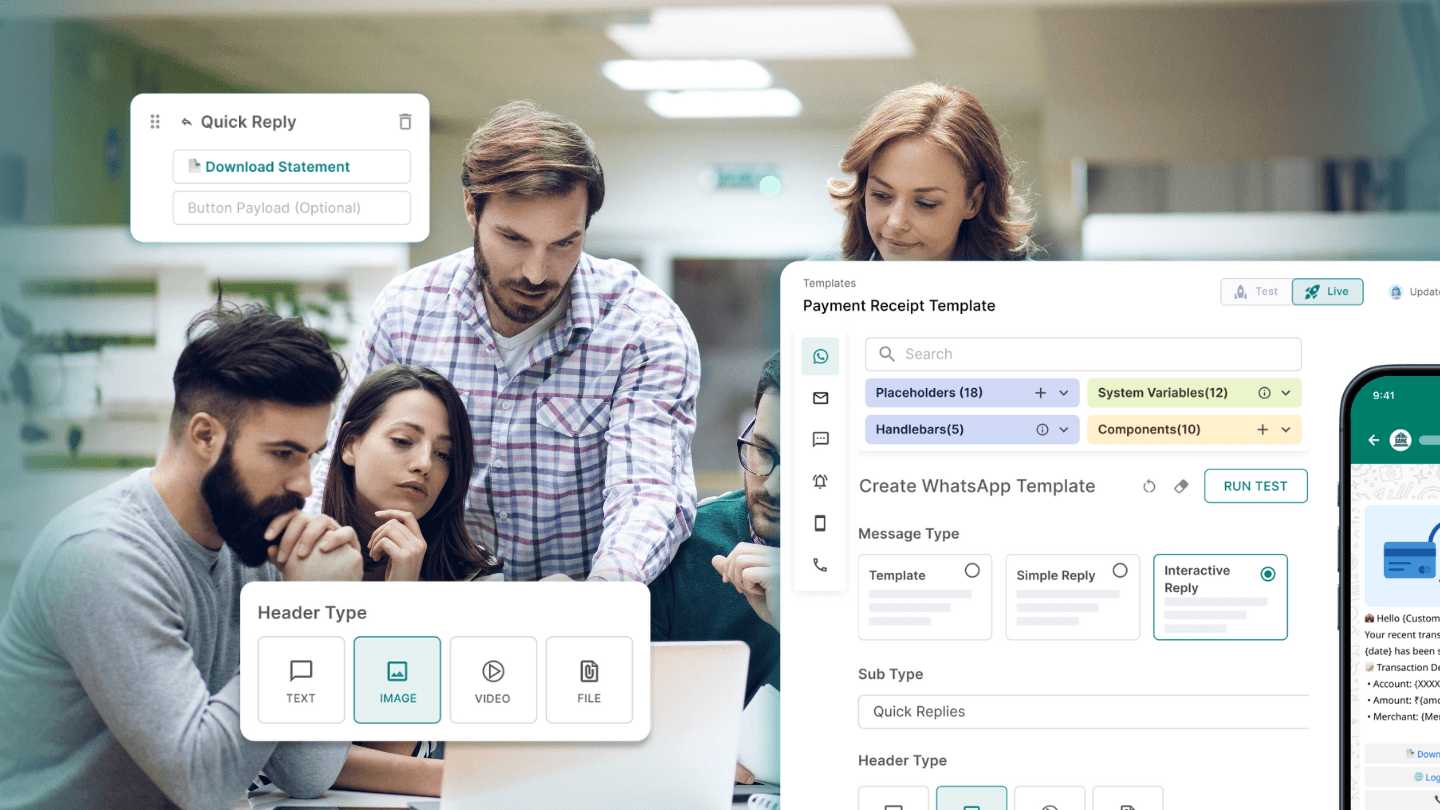What is transactional messaging?
Transactional messaging refers to automated messages triggered by specific actions performed by a consumer, delivering necessary or high-priority information. These messages include order confirmations, password resets, account alerts, and delivery updates.
Unlike promotional messages, which aim to build brand loyalty and drive sales, transactional messages provide critical information that enhances customer satisfaction and trust by delivering timely and relevant updates.

Common types of transactional messages
Transactional messages come in various forms and serve multiple purposes. Common types include:
Order confirmation messages: Sent immediately after purchase, confirming order details and providing tracking information. These messages are crucial for ensuring trust and providing a positive customer experience.
Password reset notifications: Assist users in securely resetting their passwords.
Account alerts: Notify customers of changes or important updates related to their accounts.
Delivery updates: Provide real-time tracking information for shipments.
Appointment reminders: Remind customers of upcoming appointments, often allowing for confirmation or rescheduling.
These messages can be delivered through multiple channels, such as email, SMS, and push notifications, ensuring that critical information reaches customers promptly and effectively.
Why is transactional messaging important?
Transactional messaging is crucial for businesses because it enhances customer engagement and trust. Transactional messages include order confirmations, shipment notifications, and password resets, essential for maintaining smooth customer communication. These messages ensure customers receive timely transaction updates, improving their overall experience. Transactional messaging is also important for providing real-time information, which helps businesses build credibility and reliability.
Obtaining explicit consent for customers to receive transactional SMS, as required by the Telephone Consumer Protection Act (TCPA), is essential. This ensures compliance with regulations and sets clear consumer expectations.
In addition, transactional notifications can significantly reduce the workload on customer service teams by providing automated updates. This reduces the number of inquiries related to order status or account information. SMS transactional messages, for example, can quickly inform customers about their orders’ status, reducing the need for follow-up calls or emails.
Furthermore, transactional text messages have a high open-rate compared to promotional messages. According to a study by MobileSquared, transactional SMS messages boast an open rate of 98%, compared to the 20% open rate of email marketing. This high engagement rate highlights the effectiveness of transactional messaging in reaching customers promptly.
Benefits of transactional messaging
Transactional messaging offers several benefits for businesses across various industries. One of the primary benefits is improved customer satisfaction. Customers who receive timely and relevant transaction updates are more likely to trust the business and continue engaging with it.
It is also crucial to follow transactional SMS best practices to ensure a better customer experience and to avoid overloading the customer service department.
Send critical information
Transactional messaging allows businesses to send messages containing critical information promptly. Transactional notifications ensure that vital information is delivered quickly, enhancing security and trust. For instance, in the BFSI sector, customers receive alerts about suspicious transactions immediately, which helps prevent unauthorized activities.
Build trust
Building trust with customers is crucial for any business. Transactional messaging plays a significant role in providing accurate and timely updates. Customers rely on these messages for essential information, such as order confirmations and delivery updates. When businesses consistently deliver on these expectations, they foster a sense of reliability and trustworthiness.
Improve engagement
Another significant benefit of transactional messaging is improving customer engagement. Customers are more likely to interact with and respond to messages that contain relevant and necessary information.
For example, logistics companies can use transactional text messages to keep customers informed about the status of their shipments. This not only improves customer satisfaction but also encourages repeat business.
Gather insights
Transactional messages can also help businesses gather valuable insights. Companies can better understand customer behaviour and preferences by analyzing transactional APIs or transactional SMS data. This information can be used to improve services and tailor future communications to meet customer needs more effectively.
For example, tracking the open rates and responses to transactional notifications can provide insights into customer engagement levels and preferences.
Differences between transactional and promotional messages
Promotional and transactional SMS serve different engagement strategies; promotional SMS focuses on marketing and advertising, while transactional SMS provides important information.
Understanding the differences between transactional messages and promotional messages is crucial for businesses to communicate effectively with their customers.
Transactional messaging involves sending messages essential to completing a transaction or providing important updates related to a service. On the other hand, promotional SMS and text messages are intended to market a product or service, aiming to drive sales or engagement.
Transactional messages include order confirmations, shipping updates, and account alerts. These messages are typically automated and triggered by user actions, ensuring the timely delivery of critical information. Promotional SMS, such as discount offers, new product announcements, and special deals, require explicit consent from recipients due to their marketing nature.
The primary distinction lies in the purpose and content of the messages. Transactional notifications focus on delivering necessary information, while promotional text messages aim to encourage customer engagement and sales. This fundamental difference dictates these messages’ consent mechanism, frequency, and format.
Key differences
Purpose, content, and consent requirements
Transactional text messages are primarily informative, providing updates and confirmations about customer interaction with a business. These messages are critical for maintaining customer satisfaction and trust, as they inform customers about their transactions.
Promotional SMS messages, however, are designed to generate interest and drive action. They often include enticing offers, discounts, and calls to action. Due to their marketing nature, promotional SMS messages require prior consent from the recipients, usually obtained through an opt-in process.
Delivery frequency
Transactional SMS messages are sent based on specific triggers, such as a purchase or an account update, ensuring they are relevant and timely.
In contrast, promotional messages are often sent according to a marketing schedule, which can be more frequent and less predictable.
Consent mechanism for promotional and transactional messages
The consent mechanism for transactional and promotional messages differs significantly due to their nature. Transactional messaging does not require explicit consent as it is related to a service the customer has already engaged with. For example, when a customer makes a purchase, they expect to receive an order confirmation and shipping updates.
Conversely, promotional messages must comply with regulations that mandate explicit consent from recipients. This often involves a double opt-in process where customers confirm their willingness to receive marketing communications. This consent is crucial to avoid penalties and maintain customer trust. Legal requirements and best practices for obtaining opt-in consent for sending marketing messages include clearly disclosing what the customer is consenting to and providing an easy way to opt-out.
The transactional API plays a significant role in managing these communications, ensuring that transactional messages are delivered promptly and efficiently. Businesses must implement robust systems to differentiate between transactional and promotional messages, ensuring compliance with consent requirements and providing a seamless communication experience for customers.
A clear and compliant consent mechanism is vital for businesses to avoid legal issues and maintain positive customer relationships. By understanding and respecting the differences between transactional and promotional messages, businesses can communicate more effectively and enhance customer satisfaction.
Channels for sending transactional messages
Selecting the right channel for sending transactional messages ensures timely and effective communication. Different channels offer unique advantages, depending on the message’s urgency and the customer’s preferences.
The section below explores three primary channels businesses use to deliver transactional notifications efficiently.
SMS
Email
In-app messaging

SMS
Transactional messages sent via SMS are effective for immediate and direct communication. They boast an open rate of over 98%, making them ideal for urgent notifications like OTPs (one-time passwords) and delivery updates.
BFSI (Banking, Financial Services, and Insurance) companies use transactional SMS to alert customers about account activities, detect fraud, and confirm payments.
Similarly, logistics companies notify customers about shipment statuses, ensuring timely and reliable communication. Transactional text messages ensure that important information reaches customers promptly, enhancing the customer experience.
Emails are a versatile and widely used channel for transactional messaging. Businesses use transactional emails for order confirmations, password resets, and account notifications. According to Campaign Monitor, the average open rate for transactional emails is 44.7%, significantly higher than for promotional emails.
In the BFSI sector, banks send transactional notifications via email to inform customers about transactions, statements, and policy updates.
Logistics companies utilize transactional email to provide detailed shipment tracking and delivery confirmation. This ensures that customers have all the necessary information in one place, improving transparency and trust.
In-App messaging
In-app messaging is an effective channel for transactional messaging, especially for businesses with a mobile app presence. Transactional messages delivered through in-app messaging can include account updates, security alerts, and personalized notifications.
This method is particularly beneficial for the BFSI sector, where users can receive real-time updates about their account activities directly within their banking app.
Logistics companies use in-app messaging to provide real-time shipment updates, enhancing customer satisfaction by informing them at every step. The immediacy and convenience of in-app messaging make it a powerful tool for transactional notifications.
Examples and use cases of transactional messages
Transactional messages are essential for maintaining efficient and reliable communication with customers. Below are examples of transactional messages.
User authentication
One-time passwords (OTPs)
Two-factor authentication (2FA)

Bookings and appointments
Reservation confirmation and cancellation
Appointment confirmation and reminders

Service notifications and alerts
Payment and billing alerts
Service updates
Welcome messages
Support ticket confirmations

E-commerce
Receipts
Order confirmation and status updates
Shipping and delivery updates
Abandoned cart reminders
Product alerts
Feedback requests and surveys

Government and other organizations
General alerts and notices
Emergency alerts

Internal communication
People updates
Notifications for shift changes
Notifications for birthdays and work anniversaries
Company newsletter sharing

10 best practices for transactional messaging
Transactional messaging is essential for maintaining effective communication with your customers. To maximize its impact, follow these 10 best practices.
Keep it clear and concise
Speed is key
Focus on the customer
Add an NPS survey
Go beyond open rates
Cover the WWWWH (Who, What, When, Where, How)
Mobile optimisation
Provide clear instructions on how to opt out
Use a professional transactional messaging service
Stay short and sweet
Keep it clear and concise
Ensure your transactional messages are clear and concise. Customers appreciate short, to-the-point information. Avoid unnecessary details to prevent confusion.
Speed is key
Deliver transactional messages promptly. Timeliness enhances the customer experience and fosters trust. Delays can lead to dissatisfaction and missed opportunities.
Focus on the customer
Tailor your messages to meet customer needs. Personalization increases engagement and relevance. Use customer data to craft messages that resonate with your audience.
Add an NPS survey
Include a Net Promoter Score (NPS) survey in your transactional messaging. Gathering feedback helps improve your services. It also shows customers that their opinions matter.
Go beyond open rates
Analyze more than just open rates. Track metrics like click-through rates and conversion rates to understand the effectiveness of your transactional messages.
Cover the wwwwh (who, what, when, where, how)
Address the Who, What, When, Where, and How in your messages. Providing comprehensive information ensures customers understand the message and its purpose.
Mobile optimization
Optimize your messages for mobile devices. A significant portion of customers access emails via mobile. Ensure your messages are readable and actionable on small screens.
Provide clear instructions on how to opt-out
Include clear instructions on how to opt out of transactional messages. Respecting customer preferences builds trust and complies with legal requirements.
Use a professional transactional messaging service
Consider using a professional transactional messaging service. Expert services ensure reliability and compliance with industry standards.
Stay short and sweet
Keep your messages short and sweet. Concise messages are more likely to be read and understood. Avoid lengthy paragraphs and stick to essential information.
How to send transactional messages efficiently with fyno
Transactional messages play a crucial role in maintaining effective communication with your customers. If you want to enhance customer engagement, use transactional messages with Fyno. These messages include transactional notifications such as order confirmations, shipping updates, and appointment reminders.
Transactional messaging is essential because it ensures the timely delivery of important information. Customers appreciate receiving transactional text messages that keep them informed about their transactions. This builds trust and improves the overall customer experience.
DLT registrations
Register with DLT (Distributed Ledger Technology) to comply with regulatory requirements. This process ensures that all transactional messages are verified and legitimate. DLT registration helps prevent spam and unauthorized messaging, safeguarding your communication channels. DLT registration is crucial for sending secure transactional SMS to customers. Financial institutions must verify that their messages comply with regulations to maintain customer trust and avoid penalties.
Service explicit
Service explicit messages clearly state their purpose and provide detailed information about the service. When you use service-explicit messages, you ensure that the recipient fully understands the nature and intent of the communication. This is especially important for critical updates and confirmations.
For instance, a bank might send a service explicit message like, "Your loan application #56789 has been approved. Please review the terms and conditions at [link]." This message provides clear information about the approval and what the recipient needs to do next.
Service implicit
Service implicit messages, on the other hand, convey information in a more general manner without going into extensive detail. These messages assume that the recipient can infer the purpose of the message from the context. Service implicit messages are often used for routine updates and reminders.
An example of an implicit service message could be, "Reminder: Your credit card payment is due on June 15th. Please ensure timely payment to avoid late fees." While it doesn't detail the consequences or next steps, it provides enough information for the recipient to understand and take action.
Effortlessly using both service explicit and service implicit messages can enhance your communication strategy. Service explicit messages are best for complex or critical communications, while service implicit messages work well for routine updates.
Fyno verify
Fyno Verify is a powerful tool that enhances the security and reliability of your transactional messaging. This feature allows you to verify the authenticity of each transactional message before it reaches the recipient, adding an extra layer of protection to your communications.
For instance, logistics companies can use Fyno Verify to ensure delivery updates and notifications are accurate and trustworthy. This helps reduce errors and improve customer satisfaction.
Fyno shorty
Another useful feature is Fyno Shorty, which allows you to create short, concise URLs for messages. This is useful for SMS communications where character limits apply.
For example, you can use Fyno Shorty to send a quick order tracking link in a single SMS. This ensures that customers receive the information they need while saving costs for you.
Examples of effective transactional messages
Effective transactional messages are clear, concise, and timely. Here are a few examples to illustrate their impact:
Order Confirmation: "Your order #12345 has been confirmed and will be shipped soon. Thank you for shopping with us!"
Shipping Update: "Your package is on its way! Track your shipment here: [Fyno Shorty link]."
Appointment Reminder: "Reminder: Your appointment with Dr. Smith is scheduled for June 5th at 3 PM."
These examples demonstrate how transactional messages can enhance customer experience by providing timely and relevant information. In banking, transactional notifications like account balance updates or fraud alerts are crucial for maintaining customer trust and engagement.
FAQs
1. How do transactional messages differ from promotional messages?
Transactional messages provide essential updates, while promotional messages aim to drive sales.
2. What are common examples of transactional messages?
Order confirmations, password resets, and account alerts are common transactional messages.
3. Why are transactional SMS messages effective?
Transactional SMS messages have a high open rate of 98%, ensuring timely information delivery.
4. How can transactional messaging improve customer trust?
By delivering timely and relevant updates, transactional messaging enhances customer trust and satisfaction.
5. What role does Fyno Verify play in transactional messaging?
Fyno Verify ensures the authenticity of each transactional message, adding an extra layer of security.
6. What is the importance of DLT registration for transactional messages?
DLT registration ensures compliance and prevents spam, safeguarding communication channels.
7. How does Fyno Shorty benefit SMS communications?
Fyno Shorty creates concise URLs, optimizing SMS communications within character limits.


